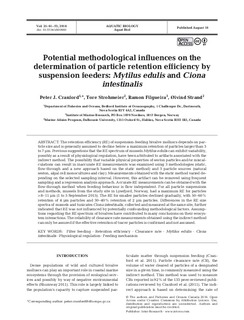Potential methodological influences on the determination of particle retention efficiency by suspension feeders: Mytilus edulis and ciona intestinalis
Journal article, Peer reviewed
Published version
Permanent lenke
http://hdl.handle.net/11250/2490941Utgivelsesdato
2016Metadata
Vis full innførselSamlinger
- Articles [3012]
- Publikasjoner fra CRIStin [3066]
Sammendrag
The retention efficiency (RE) of suspension-feeding bivalve molluscs depends on particle size and is generally assumed to decline below a maximum retention of particles larger than 3 to 7 µm. Previous suggestions that the RE spectrum of mussels Mytilus edulis can exhibit variability, possibly as a result of physiological regulation, have been attributed to artifacts associated with the indirect method. The possibility that variable physical properties of seston particles and/or miscalculations can result in inaccurate RE measurements was examined using 3 methodologies (static, flow-through and a new approach based on the static method) and 3 particle sources (natural seston, algal cell monocultures and clay). Measurements obtained with the static method varied depending on the selected sampling interval. However, this artifact can be removed using frequent sampling and a regression analysis approach. Accurate RE measurements can be obtained with the flow-through method when feeding behaviour is flow independent. For all particle suspensions and methods, mussels from the study site in Lysefjord, Norway, had a maximum RE for particles >8–11 µm (1 to 5 September 2015). The RE for smaller particles declined gradually, with 50–60% retention of 4 µm particles and 30–40% retention of 2 µm particles. Differences in the RE size spectra of mussels and tunicates Ciona intestinalis, collected and measured at the same site, further indicated that RE was not influenced by potentially confounding methodological factors. Assumptions regarding the RE spectrum of bivalves have contributed to many conclusions on their ecosystem interactions. The reliability of clearance rate measurements obtained using the indirect method can only be assured if the effective retention of tracer particles is confirmed and not assumed.
